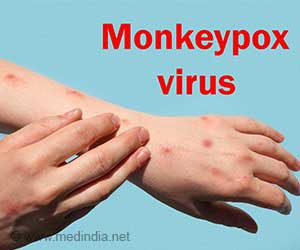
The World Health Organization (WHO) conducted an emergency meeting to discuss the recent outbreak of
. As of now, 92 confirmed monkeypox cases and 28 suspected cases have been detected from 12 countries. The number of cases is expected to increase in the coming days globally (
).
Monkeypox is a rare viral infection caused by the monkeypox virus, which belongs to the same family of
. It typically occurs in central and western Africa. Sometimes, small clusters or isolated infections are diagnosed in other countries.
History from Inception to the 2022 Outbreak
- The first known human case occurred in the Democratic Republic of Congo in 1970.
- In 1996-1997, an outbreak was reported in the Democratic Republic of the Congo with a lower fatality ratio and higher attack rate.
- In 2003, the first monkeypox outbreak outside Africa was in the United States of America and was linked to contact with infected pet dogs.
- Since 2017, Nigeria has experienced a large outbreak, with over 500 suspected cases and over 200 confirmed cases.
-
On May 18, 2022, a U.S. resident tested positive after returning to the US from Canada. Till date, WHO confirms 92 cases of monkeypox with outbreaks in 12 countries so far (2✔ ✔Trusted Source
Monkeypox – background information
Go to source
).
How do you Get Monkeypox Virus?
Transmission of monkeypox virus usually occurs due to close contact with infected animals such as rodents and monkeys and is limited between people.
According to the Centers for Disease Control and Prevention, monkeypox can be spread by anyone through contact with body fluids, monkeypox sores, or shared items (such as clothing and bedding) that have been contaminated with fluids or sores of a person with monkeypox.
The most recent surge in cases appears to have been spread among men who have sex with other men (3✔ ✔Trusted Source
Europe: WHO supporting countries affected by rare monkeypox outbreak
Go to source)
READ RELATED: High blood pressure: The G&T ingredient that may lower your reading – expert
What are the Symptoms of Monkeypox?
The infection usually starts with fever, headaches swellings, back pain, and muscle pain. Once the fever breaks, a rash can develop, often beginning on the face, then spreading to other parts of the body, most commonly the palms of the hands and soles of the feet (4✔ ✔Trusted Source
Signs and Symptoms – Monkeypox
Go to source
).
The rash can be extremely itchy or painful, that undergoes different stages before finally forming a scab, which later falls off. The lesions can cause scarring. The infection is a self-limiting disease that clears up on its own and lasts between 14 and 21 days.
Is Monkeypox Curable?
Currently, there is no proven treatment for monkeypox. Antiviral drugs may help, but they haven’t been studied as monkeypox treatment. Instead, your healthcare provider will monitor your condition and try to relieve your symptoms.
Most people get better on their own without treatment. If there is an outbreak of monkeypox in multiple people, the smallpox vaccine, antivirals, and vaccinia immune globulin (VIG)can be used as options to control the spread of the disease (5✔ ✔Trusted Source
Treatment – Monkeypox
Go to source).
How to Prevent Monkeypox Virus?
The main strategy to prevent the monkeypox virus depends on limiting human contact with infected animals and limiting person-to-person spread. You can prevent the monkeypox virus in the following ways:
- Avoid contact with infected animals (especially sick or dead animals).
- Avoid contact with bedding and other materials contaminated by the person infected with the virus.
- Wash your hands with soap and water after coming into contact with an infected animal.
- Only eat foods that contain animal meat or parts after washing and cooking.
- Use personal protective equipment (PPE)when caring for people infected with the virus.
-
Information about all recent travel and attendance of mass gathering events, festivals, and parties, and contact with any known cases should be informed to the health care professionals (6✔ ✔Trusted Source
Situation Update – Monkeypox
Go to source
).
Now, Belgium is the first country in the world to announce a mandate of 21-day quarantine for monkeypox patients. Monkeypox may appear scary, but it is relatively uncommon and not a deadly disease if basic protective measures are taken. Follow the prevention protocols and keep your mind calm in this panicking situation.
References:
- Multi-country monkeypox outbreak in non-endemic countries – (https://www.who.int/emergencies/disease-outbreak-news/item/2022-DON385)
- Monkeypox: background information – (https://www.gov.uk/guidance/monkeypox)
- Europe: WHO supporting countries affected by rare monkeypox outbreak – (https://news.un.org/en/story/2022/05/1118712)
- Monkeypox – Signs and Symptoms – (https://www.cdc.gov/poxvirus/monkeypox/symptoms.html)
- Monkeypox – Treatment – (https://www.cdc.gov/poxvirus/monkeypox/clinicians/treatment.html)
- Situation Update: Monkeypox – (https://www.nicd.ac.za/situation-update-monkeypox/)
Source: Medindia
Source:
Leave a Reply